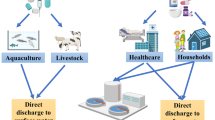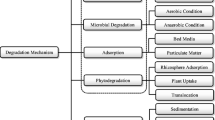Abstract
Constructed wetlands (CWs) and algae tanks are regarded as promising polishing steps to treat wastewaters for the removal of persistent organic pollutants, such as pharmaceuticals and personal care products (PPCPs). In this systematic review, we provide a synthesis of the relationship between the presence of the most widely studied PPCPs in domestic wastewater and the conformation of the CWs and algae tanks constructed to treat them. The six drugs most commonly found in the reviewed articles were caffeine, carbamazepine, diclofenac, ibuprofen, ketoprofen, and naproxen. Removal efficiency of the PPCPs was evaluated by means of the following selected parameters: hydraulic retention time (HRT), system flow rate, temperature, inflow concentration, and average removal rate. The average removal rate of PPCPs in CWs showed a positive and moderate relationship with the HRT (r = 0.346). A different flow configuration and plant species acted better for different target compounds. The average concentration reduction ranged from 80% for caffeine to zero reduction levels in some conformations for carbamazepine, diclofenac, and ketoprofen. There was a wide variation in the concentration reduction of different plant genera or unplanted tanks, ranging from 81% (caffeine using Phragmites sp.) to no reduction in an unplanted tank for diclofenac. The algae tanks were more efficient in removing most of the six target compounds than the wetlands. Removal rates ranged from 50% for ketoprofen to 16% for naproxen. According to our results, a combination of CW systems and algae tanks might be an effective alternative for the removal of PPCPs from domestic wastewater.





Similar content being viewed by others
References
Abdallah, M. A. E., Nguyen, K. H., Ebele, A. J., Atia, N. N., Ali, H. R. H., & Harrad, S. (2019). A single run, rapid polarity switching method for determination of 30 pharmaceuticals and personal care products in wastewater using Q-Exactive Orbitrap high resolution accurate mass spectrometry. Journal of Chromatography. A, 1588, 68–76.
Avila, C., Matamoros, V., Reyes-Contreras, C., Piña, B., Casado, M., Mita, L., et al. (2014). Attenuation of emerging organic contaminants in a hybrid constructed wetland system under different hydraulic loading rates and their associated toxicological effects in wastewater. Science of the Total Environment, 470, 1272–1280.
Ávila, C., Pelissari, C., Sezerino, P. H., Sgroi, M., Roccaro, P., & García, J. (2017). Enhancement of total nitrogen removal through effluent recirculation and fate of PPCPs in a hybrid constructed wetland system treating urban wastewater. Science of the Total Environment, 584, 414–425.
Bai, X., & Acharya, K. (2017). Algae-mediated removal of selected pharmaceutical and personal care products (PPCPs) from Lake Mead water. Science of the Total Environment, 581, 734–740.
Bai, X., & Acharya, K. (2016). Removal of trimethoprim, sulfamethoxazole, and triclosan by the green alga Nannochloris sp. Journal of Hazardous Materials, 315, 70–75.
Bartrons, M., & Peñuelas, J. (2017). Pharmaceuticals and personal-care products in plants. Trends in Plant Science, 22(3), 194–203.
Boxall, A. B., Rudd, M. A., Brooks, B. W., Caldwell, D. J., Choi, K., Hickmann, S., et al. (2012). Pharmaceuticals and personal care products in the environment: what are the big questions? Environmental Health Perspectives, 120(9), 1221–1229.
Rother, E. T. (2007). Revisão sistemática X revisão narrativa. Acta paulista de enfermagem, 20(2), v–vi.
Chen, Y., Vymazal, J., Březinová, T., Koželuh, M., Kule, L., Huang, J., & Chen, Z. (2016). Occurrence, removal and environmental risk assessment of pharmaceuticals and personal care products in rural wastewater treatment wetlands. Science of the Total Environment, 566, 1660–1669.
Daughton, C. G., & Ternes, T. A. (1999). Pharmaceuticals and personal care products in the environment: agents of subtle change? Environmental Health Perspectives, 107(suppl 6), 907–938.
de Wilt, A., Butkovskyi, A., Tuantet, K., Leal, L. H., Fernandes, T. V., Langenhoff, A., & Zeeman, G. (2016). Micropollutant removal in an algal treatment system fed with source separated wastewater streams. Journal of Hazardous Materials, 304, 84–92.
DellaGreca, M., Pinto, G., Pistillo, P., Pollio, A., Previtera, L., & Temussi, F. (2008). Biotransformation of ethinylestradiol by microalgae. Chemosphere, 70(11), 2047–2053.
Dordio, A., Carvalho, A. P., Teixeira, D. M., Dias, C. B., & Pinto, A. P. (2010). Removal of pharmaceuticals in microcosm constructed wetlands using Typha spp. and LECA. Bioresource Technology, 101(3), 886–892.
Ebele, A. J., Abdallah, M. A. E., & Harrad, S. (2017). Pharmaceuticals and personal care products (PPCPs) in the freshwater aquatic environment. Emerging Contaminants, 3(1), 1–16.
Fatta-Kassinos, D., Bester, K., & Kümmerer, K. (Eds). (2010). Xenobiotics in the urban water cycle: mass flows, environmental processes, mitigation and treatment strategies (Vol. 16). Springer Science & Business Med. https://doi.org/10.1007/978-90-481-3509-7
Field, A. (2013). Discovering statistics using IBM SPSS statistics. Sage.
Fu, J., Lee, W. N., Coleman, C., Nowack, K., Carter, J., & Huang, C. H. (2019). Removal of pharmaceuticals and personal care products by two-stage biofiltration for drinking water treatment. Science of the Total Environment, 664, 240–248.
Grover, D. P., Zhou, J. L., Frickers, P. E., & Readman, J. W. (2011). Improved removal of estrogenic and pharmaceutical compounds in sewage effluent by full scale granular activated carbon: impact on receiving river water. Journal of Hazardous Materials, 185(2–3), 1005–1011.
Hijosa-Valsero, M., Matamoros, V., Martín-Villacorta, J., Bécares, E., & Bayona, J. M. (2010a). Assessment of full-scale natural systems for the removal of PPCPs from wastewater in small communities. Water Research, 44(5), 1429–1439.
Hijosa-Valsero, M., Matamoros, V., Sidrach-Cardona, R., Martín-Villacorta, J., Bécares, E., & Bayona, J. M. (2010b). Comprehensive assessment of the design configuration of constructed wetlands for the removal of pharmaceuticals and personal care products from urban wastewaters. Water Research, 44(12), 3669–3678.
Hijosa-Valsero, M., Matamoros, V., Pedescoll, A., Martin-Villacorta, J., Becares, E., Garcia, J., & Bayona, J. M. (2011). Evaluation of primary treatment and loading regimes in the removal of pharmaceuticals and personal care products from urban wastewaters by subsurface flow constructed wetlands. International Journal of Environmental Analytical Chemistry, 91(7–8), 632–653.
Joss, A., Zabczynski, S., Göbel, A., Hoffmann, B., Löffler, D., McArdell, C. S., & Siegrist, H. (2006). Biological degradation of pharmaceuticals in municipal wastewater treatment: proposing a classification scheme. Water Research, 40(8), 1686–1696.
Konnerup, D., Koottatep, T., & Brix, H. (2009). Treatment of domestic wastewater in tropical, subsurface flow constructed wetlands planted with Canna and Heliconia. Ecological Engineering, 35(2), 248–257.
Kovalova, L., Siegrist, H., Von Gunten, U., Eugster, J., Hagenbuch, M., Wittmer, A., et al. (2013). Elimination of micropollutants during post-treatment of hospital wastewater with powdered activated carbon, ozone, and UV. Environmental Science & Technology, 47(14), 7899–7908.
Littell, J. (2018). Conceptual and practical classification of research reviews and other evidence synthesis products. Oslo: The Campbell Collaboration. Retrieved from: www.campbellcollaboration.org/. https://doi.org/10.4073/cmdp.2018.1.
Llorens, E., Matamoros, V., Domingo, V., Bayona, J. M., & García, J. (2009). Water quality improvement in a full-scale tertiary constructed wetland: effects on conventional and specific organic contaminants. Science of the Total Environment, 407(8), 2517–2524.
Lorion, R. (2001). Constructed wetlands: Passive systems for wastewater treatment. US EPA Technology Innovation Office.
Luo, Y., Guo, W., Ngo, H. H., Nghiem, L. D., Hai, F. I., Zhang, J., et al. (2014). A review on the occurrence of micropollutants in the aquatic environment and their fate and removal during wastewater treatment. Science of the Total Environment, 473, 619–641.
Matamoros, V., Gutiérrez, R., Ferrer, I., García, J., & Bayona, J. M. (2015). Capability of microalgae-based wastewater treatment systems to remove emerging organic contaminants: a pilot-scale study. Journal of Hazardous Materials, 288, 34–42.
Matamoros, V., Arias, C., Brix, H., & Bayona, J. M. (2009). Preliminary screening of small-scale domestic wastewater treatment systems for removal of pharmaceutical and personal care products. Water Research, 43(1), 55–62.
Matamoros, V., Arias, C., Brix, H., & Bayona, J. M. (2007). Removal of pharmaceuticals and personal care products (PPCPs) from urban wastewater in a pilot vertical flow constructed wetland and a sand filter. Environmental Science & Technology, 41(23), 8171–8177.
Matamoros, V., García, J., & Bayona, J. M. (2008). Organic micropollutant removal in a full-scale surface flow constructed wetland fed with secondary effluent. Water Research, 42(3), 653–660.
Metcalf, L., & Eddy, H. P. (2015). Tratamento de efluentes e recuperação de recursos (wastewater engineering: treatment and resource recovery). McGraw Hill Brazil.
Packer, J. L., Werner, J. J., Latch, D. E., McNeill, K., & Arnold, W. A. (2003). Photochemical fate of pharmaceuticals in the environment: naproxen, diclofenac, clofibric acid, and ibuprofen. Aquatic Sciences, 65(4), 342–351.
Pietrangelo, L., Bucci, A., Maiuro, L., Bulgarelli, D., & Naclerio, G. (2018). Unraveling the composition of the root-associated bacterial microbiota of Phragmites australis and Typha latifolia. Frontiers in Microbiology, 9, 1650.
Reif, R., Besancon, A., Le Corre, K., Jefferson, B., Lema, J. M., & Omil, F. (2011). Comparison of PPCPs removal on a parallel-operated MBR and AS system and evaluation of effluent post-treatment on vertical flow reed beds. Water Science and Technology, 63(10), 2411–2417.
Reyes-Contreras, C., Matamoros, V., Ruiz, I., Soto, M., & Bayona, J. M. (2011). Evaluation of PPCPs removal in a combined anaerobic digester-constructed wetland pilot plant treating urban wastewater. Chemosphere, 84(9), 1200–1207.
Salomão, A. L. S., Marques, M., Severo, R. G., & da Cruz Roque, O. C. (2012). Engineered ecosystem for on-site wastewater treatment in tropical areas. Water Science and Technology, 66(10), 2131–2137.
Song, H. L., Nakano, K., Taniguchi, T., Nomura, M., & Nishimura, O. (2009). Estrogen removal from treated municipal effluent in small-scale constructed wetland with different depth. Bioresource Technology, 100(12), 2945–2951.
Tran, N. H., Urase, T., Ngo, H. H., Hu, J., & Ong, S. L. (2013). Insight into metabolic and cometabolic activities of autotrophic and heterotrophic microorganisms in the biodegradation of emerging trace organic contaminants. Bioresource Technology, 146, 721–731.
Yangali-Quintanilla, V., Maeng, S. K., Fujioka, T., Kennedy, M., Li, Z., & Amy, G. (2011). Nanofiltration vs. reverse osmosis for the removal of emerging organic contaminants in water reuse. Desalination and Water Treatment, 34(1–3), 50–56.
Zhang, C., Ning, K., Zhang, W., Guo, Y., Chen, J., & Liang, C. (2013b). Determination and removal of antibiotics in secondary effluent using a horizontal subsurface flow constructed wetland. Environmental Science: Processes & Impacts, 15(4), 709–714.
Zhang, D. Q., Hua, T., Gersberg, R. M., Zhu, J., Ng, W. J., & Tan, S. K. (2013a). Fate of caffeine in mesocosms wetland planted with Scirpus validus. Chemosphere, 90(4), 1568–1572.
Zhang, D. Q., Tan, S. K., Gersberg, R. M., Sadreddini, S., Zhu, J., & Tuan, N. A. (2011). Removal of pharmaceutical compounds in tropical constructed wetlands. Ecological Engineering, 37(3), 460–464.
Zhang, D., Ni, W., Gersberg, R. M., Ng, W. J., & Tan, S. K. (2015). Performance characterization of pharmaceutical removal by horizontal subsurface flow constructed wetlands using multivariate analysis. CLEAN–Soil, Air, Water, 43(8), 1181–1189.
Zhu, S., & Chen, H. (2014). The fate and risk of selected pharmaceutical and personal care products in wastewater treatment plants and a pilot-scale multistage constructed wetland system. Environmental Science and Pollution Research, 21(2), 1466–1479.
Zimmels, Y., Kirzhner, F., & Malkovskaja, A. (2006). Application of Eichhornia crassipes and Pistia stratiotes for treatment of urban sewage in Israel. Journal of Environmental Management, 81(4), 420–428.
Author information
Authors and Affiliations
Corresponding author
Ethics declarations
Competing Interests
The authors declare that they have no conflict of interest.
Additional information
Publisher’s Note
Springer Nature remains neutral with regard to jurisdictional claims in published maps and institutional affiliations.
Rights and permissions
About this article
Cite this article
Rabello, V.M., Teixeira, L.C.R.S., Gonçalves, A.P.V. et al. The Efficiency of Constructed Wetlands and Algae Tanks for the Removal of Pharmaceuticals and Personal Care Products (PPCPs): a Systematic Review. Water Air Soil Pollut 230, 236 (2019). https://doi.org/10.1007/s11270-019-4304-9
Received:
Accepted:
Published:
DOI: https://doi.org/10.1007/s11270-019-4304-9




